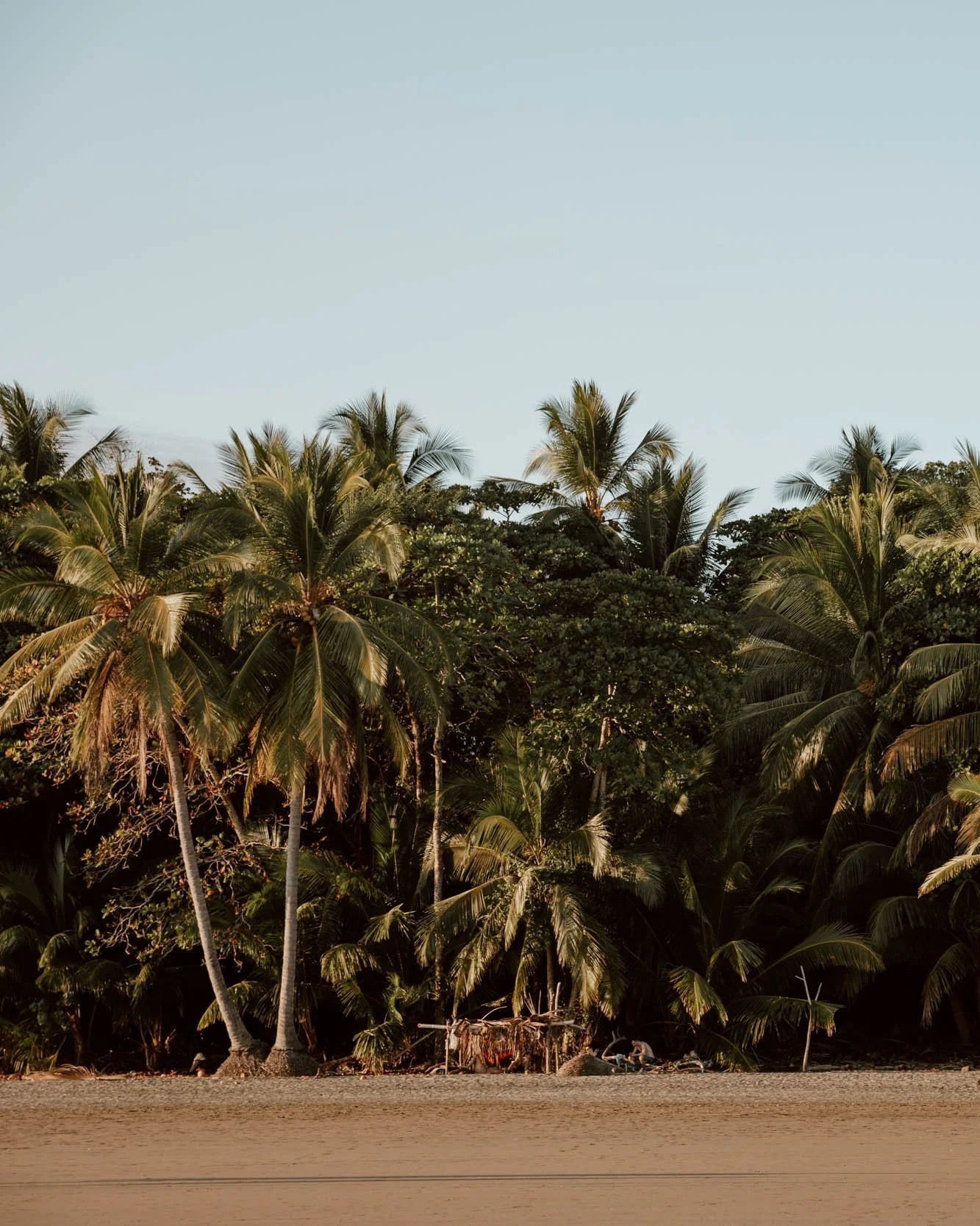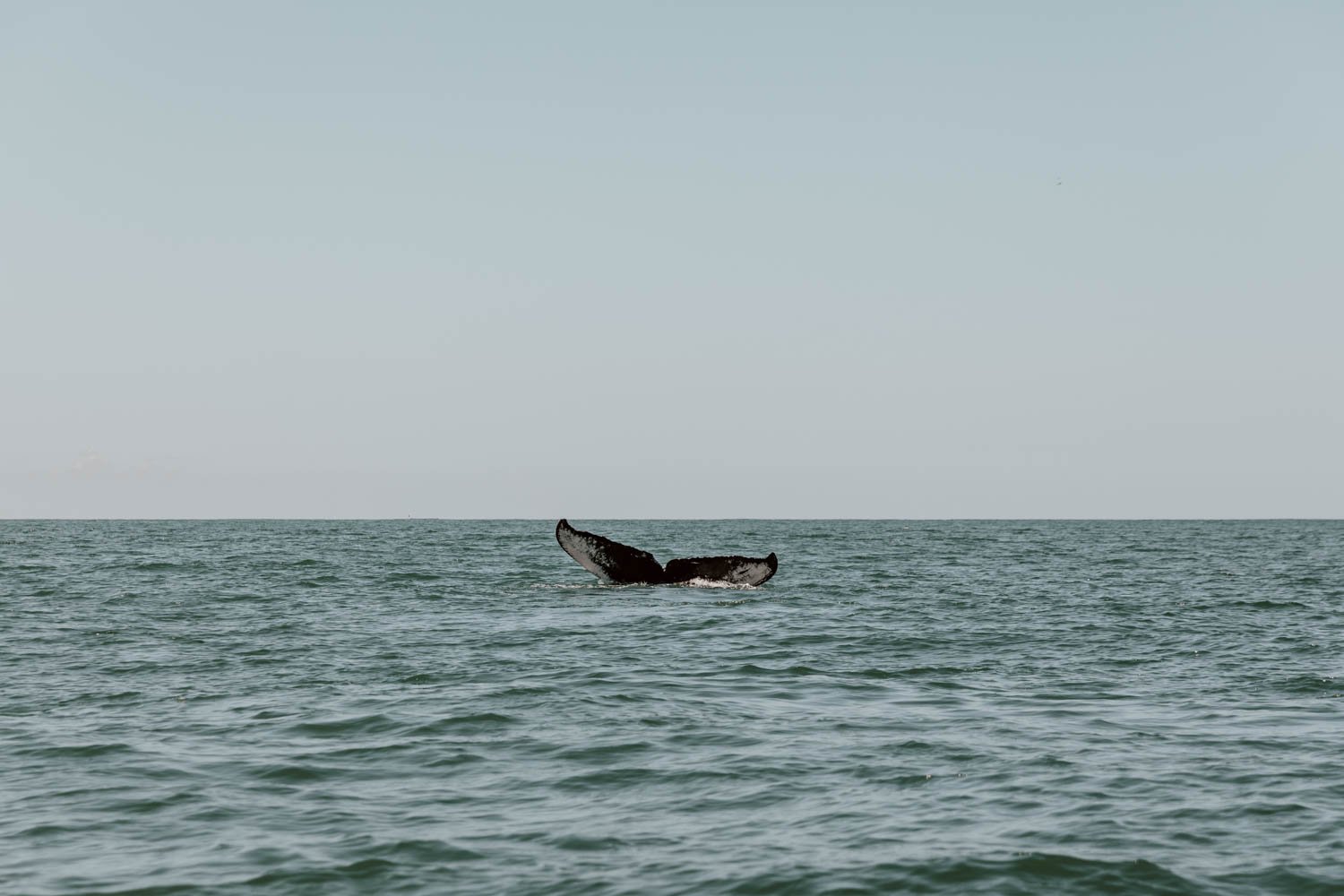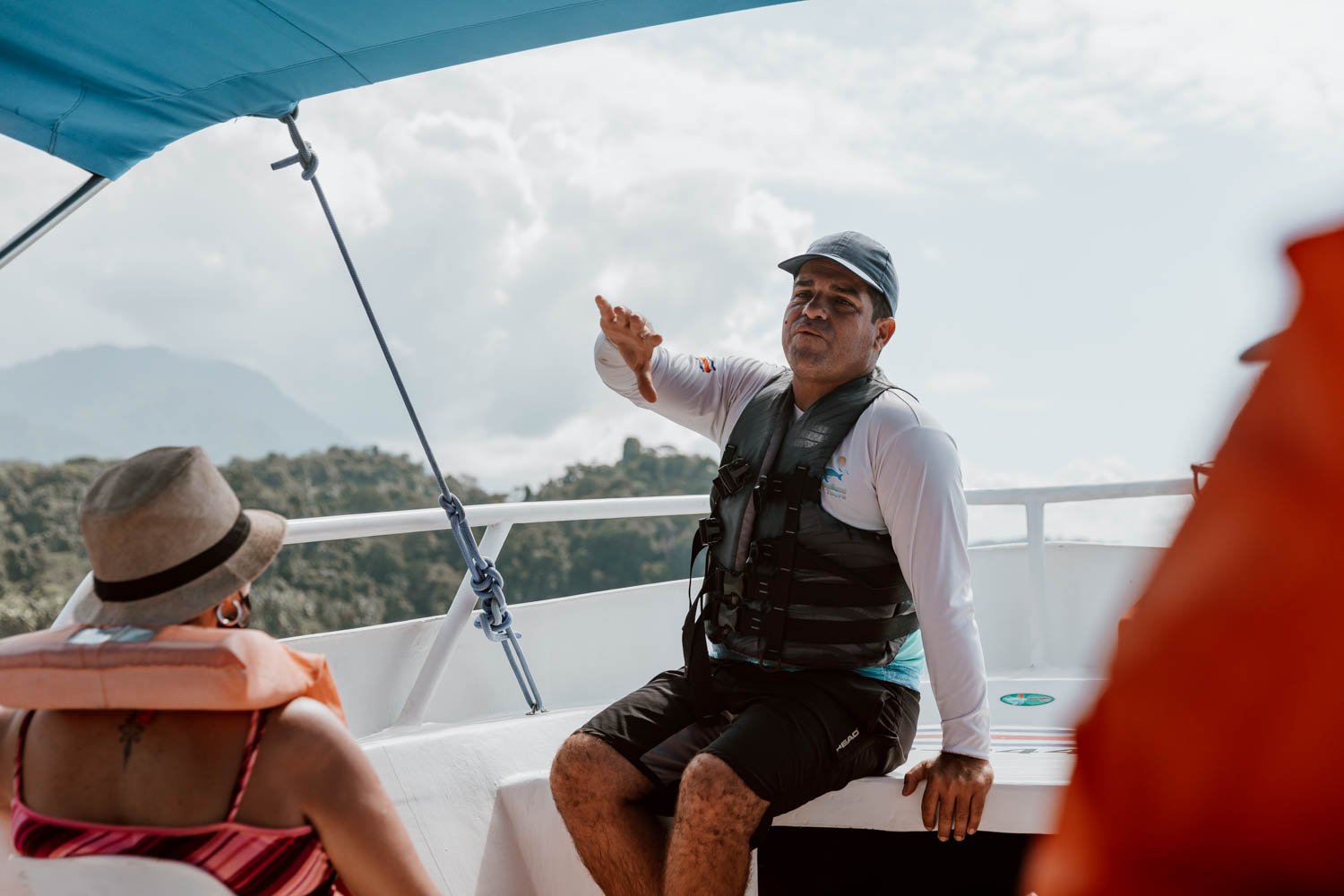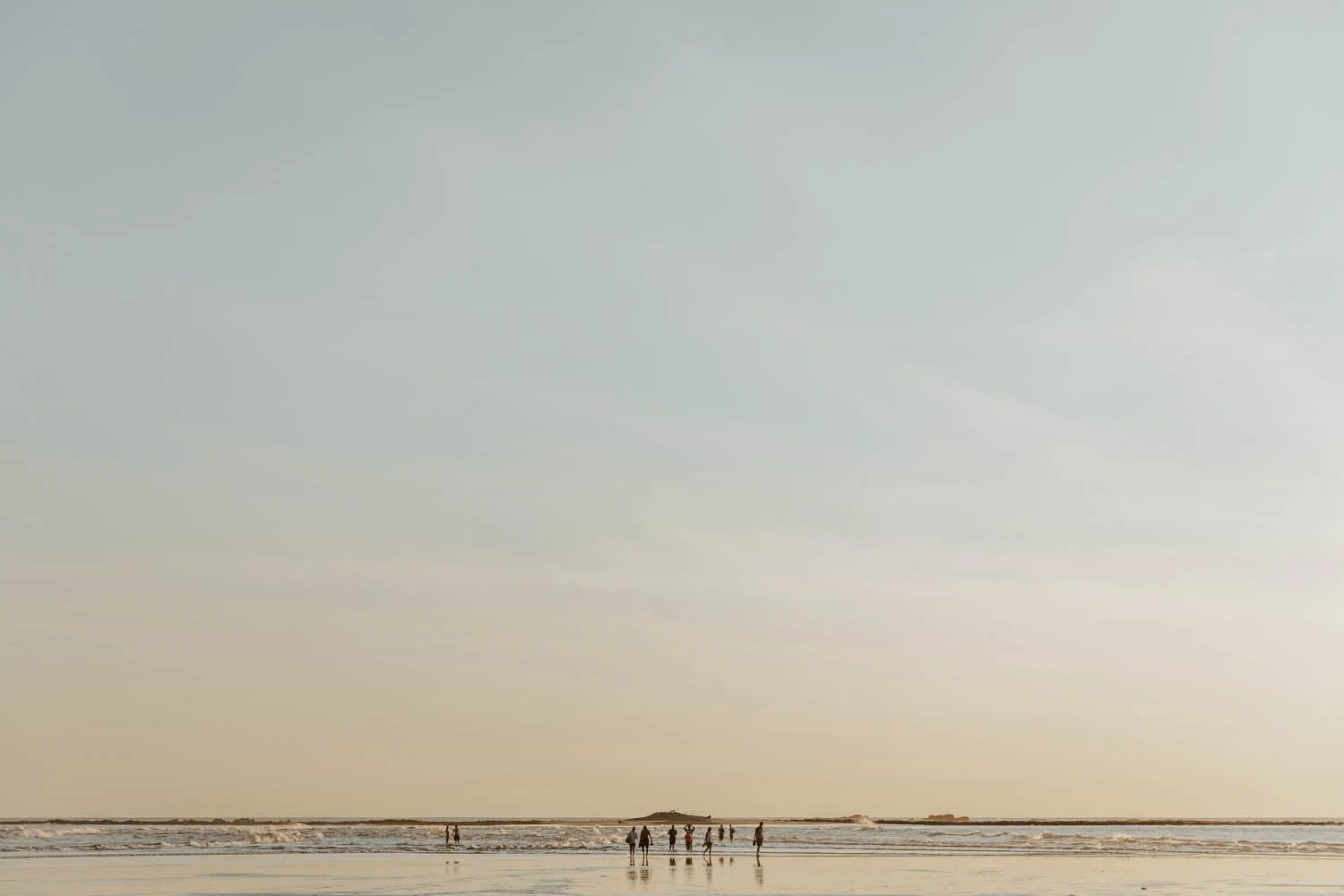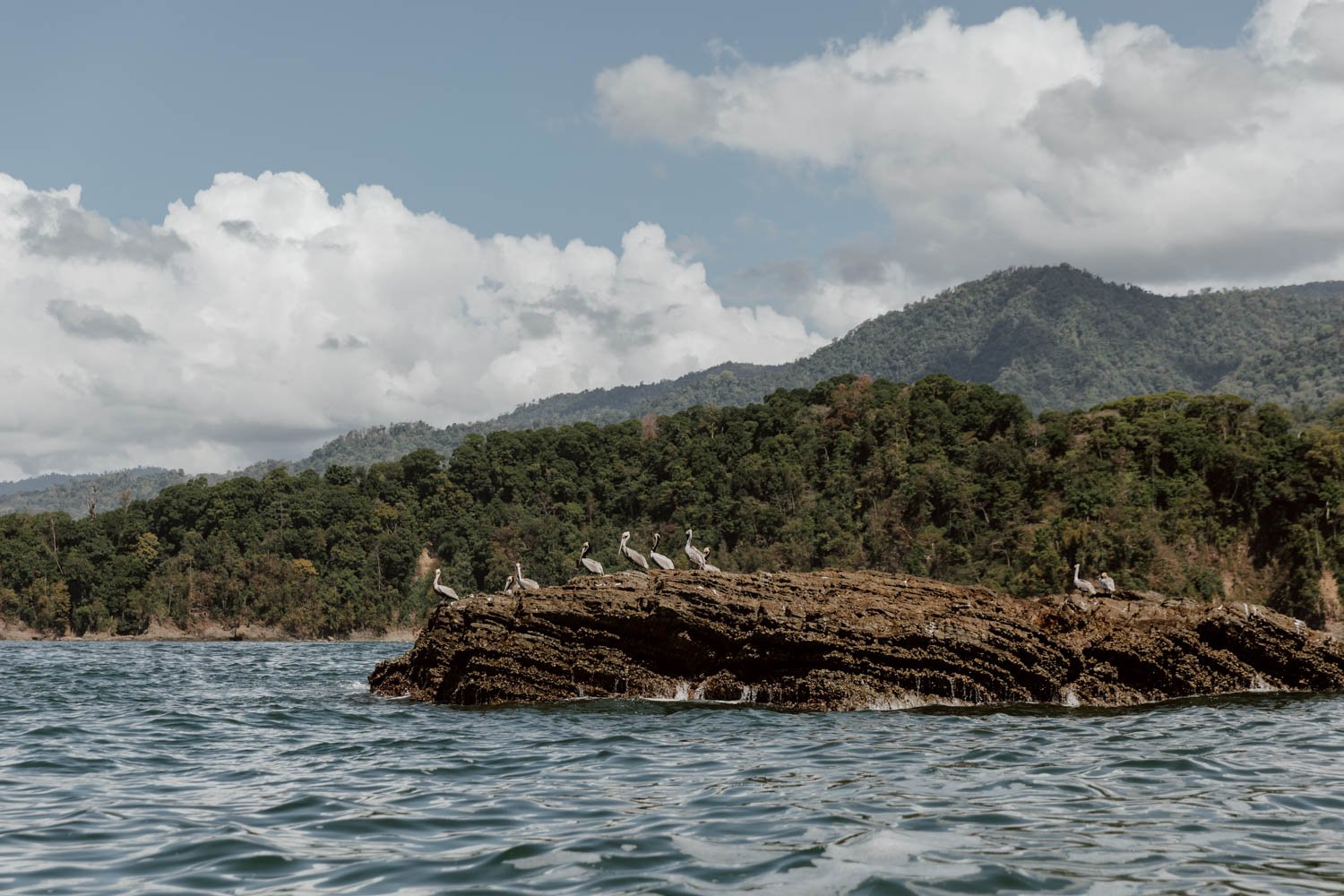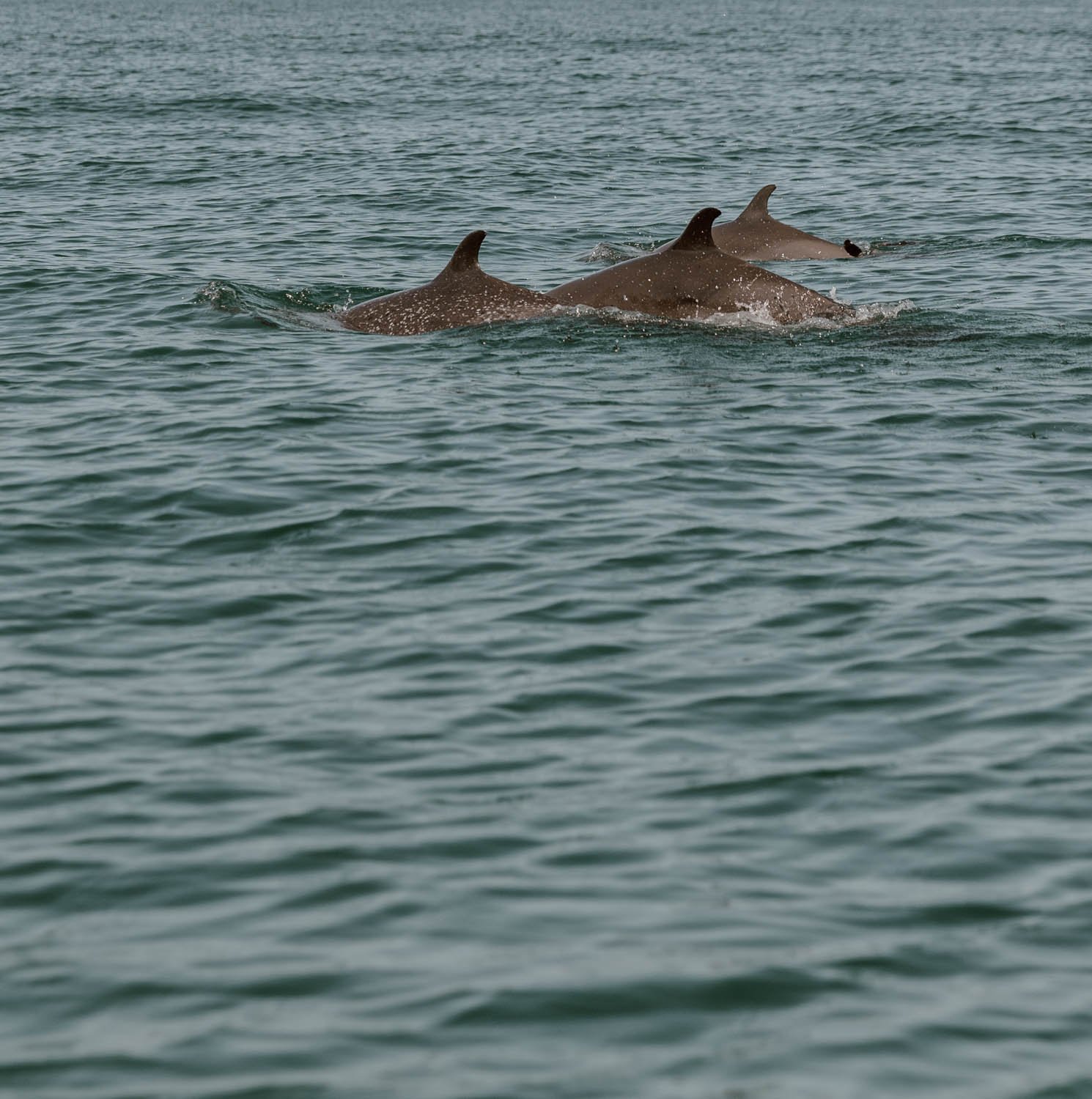Located by the laidback town of Uvita, the Marino Ballena National Park is a must-do for anyone travelling along the Pacific Coast of Costa Rica. Discover everything you need to know for a visit in our guide.
Which came first: the whales or the whale tail?
Here on the Pacific Coast of Costa Rica, there’s a most curious case of nominative determinism. Twice a year, humpback whales swim toward the warm waters in order to mate or give birth. The setting on land is absolute paradise: palm trees, golden sands, sunshine, and not a single high-rise in site.
Indeed, the whales are certainly not the only mammals who flock here for mating purposes…
But, when the tides are low in a corner of this paradise, the waters part to reveal something that really can only be described as a whale tail.
Not an actual whale’s tail, though that would be more expected, but a strip of sand stretching out to a stage of rocks which, when viewed from above, does look remarkably like a the tail of a whale.
Is this what first attracted the giant creatures here so long ago? Or, did the land take its inspiration from the shapes seen in the depths? Or is it just a fateful, happy coincidence, a serendipitous quirk of nature?
Whichever version you lean to, the whales and their tails meant there could really only be one name for this national park in Costa Rica.
Created in 1990, Parque Nacional Marino Ballena (Whale Marine National Park ) protects over 13,000 acres of ocean, 9 miles of stunning coastline and the largest coral reef along the Pacific coast of Central America. Relatively young by the country’s national park standards, it is firmly established as a gorgeous place to have a day at the beach and, unquestionably, the best place to go whale watching in Costa Rica!
In this short post, we’ve shared a personal overview of Marino Ballena National Park, with all the information + inspiration to plan your visit perfectly.
Marino Ballena National Park Essentials
// One of only two marine national parks in Costa Rica
// By the beach town of Uvita
// Best place to go whale watching
// $6 per person to enter
// Various hiking trails, beaches and water-based activities
Best Time to Visit Marino Ballena National Park
If you’re visiting Uvita with the sole purpose of seeing whales, it’s essential that you check in advance of your arrival that the whales are actually there!
Whilst there are two distinct whale watching seasons here (one for the Southern Hemisphere Humpbacks, and another for the Northern Hemisphere Humpbacks), there are a couple of months where the waters along this section of the coast are empty.
The very best time to visit Marino Ballena National Park to see whales is between mid-December and end of April, and then the end of July to mid-November. Do note that visiting at the start or tail end of these seasons reduces the likelihood of sightings.
Another issue to take into consideration is the rainy season. It affects Costa Rica’s Pacific coast between the months of May to mid-December, with a dramatic peak from September to November. Visiting during these months is certainly still possible as there are often several hours a day of sunshine and far fewer tourists, but it does mean no full days of lying in the sun, especially muddy hiking trails (some of which are closed during the rainy season), and rougher seas during storms.
Tip // Even if there are no whales to see, or your don’t plan on taking a tour to see them, we still think Uvita is one of the best places to base yourself on the Pacific Coast of Costa Rica. Find out why in 13 Wonderful Things To Do in Uvita
How to Get to marino ballena national park
Although the park can be accessed via four separate sectors - Uvita, Colonia, Ballena and Pinuela - almost all of you reading this guide will arrive at the Uvita access point (maps). This is where whale watching tours leave from, and where you will access Whale Tail Beach.
To park, you can either opt for nearby on-street parking (only really possible if you arrive early), or alternatively, select a nearby carpark a couple of minutes walk from the entrance. It costs 2000 colones to park all day, and you can find it here.
Entry Fees & Times
The entry fee for Marino Ballena National Park is $6 USD + IVA per person. This is payable upon arrival to the ticket office, and at the time of writing, must be paid by card.
Children under 11 do not pay to enter.
Purchase of the ticket allows you re-admission for the entire day, meaning you can head out to one of the nearby restaurants for lunch and then re-enter for the afternoon. This is a particularly good idea if you’re joining a whale watching tour in the morning and would like to spend the rest of the day at the beach.
The park admits people from 7am - 4pm, but you can stay within it until 6 pm.
We recommend you stay until sunset, when deep pinks and purples in the sky transform the beach.
Things to Do in Marino Ballena National Park
Whether you’re staying around the area for a couple of days or only have a few hours, there’s plenty going on within the park to keep you occupied.
Whale Watching
As we mentioned earlier in this article, Uvita is considered the best place in Costa Rica to spot whales, with two seasons that between them span much of the year.
To see them however, you’ll need to join a whale watching tour. There are countless companies in Uvita offering this experience, with prices ranging from $50 - $100 per person. Although it’s not cheap, after our own morning where we saw a young humpback male breach several times in close proximity to our boat (and a lot of playing dolphins), it’s most certainly worth it.
To find out more, be sure to read our complete guide to whale watching in Uvita.
Take a Walk Along the Whale’s Tail
Whether the tail or the whales came first, there’s little denying that The Whale’s Tail beach (also known as Punta Uvita) is quite a incredible quirk of nature.
Unfortunately, to get the best view you really do need a drone, and as we were visiting Nicaragua after Costa Rica - where drones are strictly forbidden - we were unable to bring ours. Hence, no photos.
If you don’t have one, consider heading to the observation platform at the end of Uvita beach (maps). It’s not great, but it’s better than nothing!
Tip // If being able to walk the length of the Whale’s Tail is super important to you, be sure to check the tides for the day you plan to visit. Most accommodations the area will advertise this somewhere in reception, or alternatively check this website.
Additionally, if you happen to be along the Tail before the tide is fully out, please be careful as the current is incredibly strong and could be potentially very dangerous.
The sunsets are also SPECTACULAR in and around the Tail and the patterns in the sand when the tide goes out are fascinating.
Laze on Uvita Beach
Playa Uvita is the sort of beach you dream about once you return home.
A huge expanse of powdery soft golden sand, backed by towering palm trees and verdant jungle, it reminded us of of beaches we’ve hiked for hours to reach (Tayrona, we’re thinking of you).
This beach is however easily accessible, and its status within a National Park protects it from the worst of human nature: there’s no litter, no parties, no barbecues and, even on a busy Saturday, there was space enough for everybody.
In short, it’s kind of perfect.
So after that whale tour, be sure to come prepared with a sarong, a good book and time to just sit, relax, exist - and appreciate how lucky you are to be here in the first place.
Travel Better | 13 Wonderful Things To Do in Uvita
Snorkelling
Whilst the very best snorkelling in the area is found off of Caño Island Biological Reserve (around 1.5 hours from Uvita), it’s perfectly possible to see aquatic life within the national park itself.
The same companies that arrange whale watching tours will also be able to arrange snorkelling trips out to the protected reef. Alternatively, if you have your own snorkel and mask (fins aren’t allowed), you can enjoy snorkelling by yourself just off of theWhale Tail at low tide. Just be careful about the current.
Hiking & Wildlife spotting
Whilst the primary function of the national park is to protect the marine area, the the park also includes 9 miles of beautiful coastline, backed by lush, dense rainforest, much of which can be explored via a number of short trails.
This makes it an ideal place to spot all sorts of indigenous wildlife including howler, capuchin, and squirrel monkeys, sloths, pizotes (members of the raccoon family) and pumas, as well as plenty of bird species that call the park home.
You can find details of the hiking trails by asking at the ticket / information centre, where you can also enquire about joining one of their bilingual wildlife spotting tours.
Visit Marino Ballena Responsibly
Litter | One of the reasons the beaches within this park are so beautiful is their pristine nature - they will only remain this way if visitors continue to look after it. Bringing coolers and picnics into the park is absolutely fine, but be sure to take with you when you leave, whatever you brought in.
Animals | If you head along any of the park’s nature trails, it’s quite possible that you’ll come very close to wild animals - remember that they are, most importantly, wild. Do not get too close, try not to interact with it, and under no circumstances should you feed the monkeys.
No fires | Campfires of any size are not permitted anywhere within the park and there’s no smoking.
Swimming | The riptides which plague Costa Rica’s pacific coastline are no joke. For even experienced swimmers, it’s advisable to remain in the shallows and educate yourself on what to do should you encounter a rip current you cannot immediately escape from.
Crime | Non-violent thefts are an unfortunate but not uncommon crime along the beaches here, especially in quieter areas. In fact, one girl who was staying in our hostel was woken by police when napping on the beach, and advised that suspicious youths may be looking to rob her while she slept. To avoid making yourself a target, try to bring to the beach only what you need, and as few valuables as possible. And never, ever, leave your possessions unattended whilst you head into the sea. You will see police patrolling on motorbikes up and down the beach, which underpins the risk of something getting swiped.
Where to Next?
13 Wonderful Things to Do in Uvita
Whale Watching in Uvita | What You Need to Know
7 Things to Know Before Visiting Manuel Antonio National Park
How to Get From San Jose to Uvita
How to Get From Uvita to Drake Bay
Our Guide to Drake Bay
Things to Know Before Visiting Corcovado National Park



